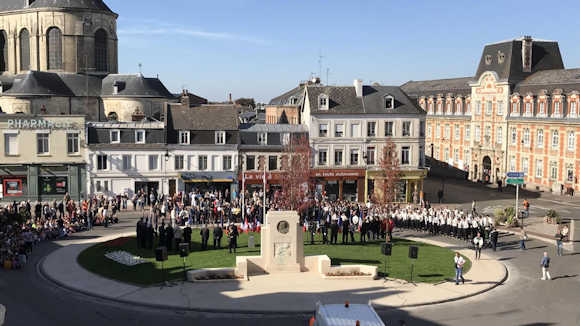Click on Imageto Enlarge
 |
| Damaged Areas and Cities of France, 1914–1918 |
Countless communities of northern France suffered devastating damage during the Great War. The map above shows the intensity of damage in various sectors.. In the green areas villages escaped most damage, in the red ("devastated") regions in some cases they were simply abandoned. Towns and cities of the occupied area, however, needed to be rebuilt no matter how serious the wartime destruction. There were strong historic and economic reasons for a large community to exist at a particular location. After the war, efforts to rebuild the cities, make the roads and infrastructure functional, bring back any evacuated citizenry, and resume commerce and normal daily life had to begin immediately. Of course, each city presented challenges particular to it. In 2019 we looked at the rebuilding of St. Quentin HERE. In this article, we look farther north at the town of Cambrai.
Cambrai 1918
Located in the Nord Department of France, near the Belgian border, the town of Cambrai (population today: 32,000) was partly destroyed during the First World War but was beautifully rebuilt. Occupied by the German Army, it was the site of two major battles fought in and around the town. The First Battle of Cambrai (20 Nov.–3 Dec. 1917)—notable for the first mass use of tanks in battle—caused the first wave of intense damage, mostly due to British Artillery. The Second Battle of Cambrai (8–10 Oct. 1918) caused similar damage in the center of the town and the northern area where German rear guard action against the Canadian troops charged with securing the town was the firmest. With the retreat of the German forces and the continued pursuit by the Canadians, the center of Cambrai was a ghost town and its residential districts suffered scattered, but serious, damage.
Cambrai: 21st Century
 |
| Restored Residential Street |
 |
| Restored City Hall |
 |
| New Art Deco Building |
 |
| Chamber of Commerce Building |
 |
| New Plaza "Octobre 1918" |
A new town, however, quickly rose from the embers. A 1919 law required disaster-stricken towns with more than 10,000 inhabitants to adapt a plan for reconstruction within three years. The architect Pierre Leprince-Ringuet was given the job of rebuilding the town. He and his colleagues, Germain Marc Debré and Jacques Debat-Ponsan, gave Cambrai new squares and streets, concentrated the administrative buildings and shops in specific areas, and designed a new town hall. They proposed an architectural mixture of the traditional and local with a modernistic approach characterized by geometric lines and stylized patterns known as Art Deco. His most honored design contribution was the Art Deco Chamber of Commerce in collaboration with Ernest Herscher. Their Cambrai project was completed by 1930, although much construction that ensued around the city followed their guidelines. Today the architecture in Cambrai’s center is a mixture of traditional regional styles and the more modern concept of Art Deco.






Lots of spelling errors - need to proofread again and correct.
ReplyDeleteHow embarrassing. Thanks for bringing this to my attention. I got so involved in the photos I forgot to check my lousy typing. I hope I've corrected everything.
DeleteNo prob. My vision is not so good either - glad your text is at least large enough for me to read!
DeleteAre there areas in this region that have remained abandoned like areas around Verdun, where the regrown woods cloak the abandoned moonscape of shell holes and barbed wire? The eeriest place I’ve ever visited. Miles and miles of battlefield still there, overgrown and shallowed out by time, but still giving up disintegrating remnants of battle, from personal items to big shells to barbed wire.
ReplyDeleteNot around Cambrai that I've ever stumbled across, Bruce.
Delete